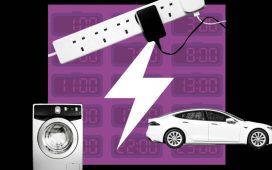If you are struggling to afford your energy bills – or you just want to make your home a bit greener – have you thought of switching to an electricity tariff that rewards those willing to shift their consumption to outside peak hours?
So far, more than 10,000 households have signed up to the UK’s best-known “time-of-use” tariff – Octopus Energy’s Agile – with many reporting they have been able to cut their electricity bills by as much as 30%.
Next month the less well-known energy provider 100Green is set to relaunch its Tide tariff that similarly promises different prices according to preset times of day.
Analysts have suggested that it is only a matter of time before more power companies offer similar deals.
National Grid ESO, which manages the network, told Guardian Money that consumer flexibility is very much considered the future by the industry.
So how do these tariffs work, and should more of us be signing up?
To be accepted on to a time-of-use tariff, you have to have a working, compatible smart meter and (usually) agree to half-hourly billing.
The general idea is that users get very cheap power during weekday nights – perhaps midnight to 7am – and cheaper power during the day, but they pay a price premium (typically 30% more) for every unit they consume at peak times – particularly between 4pm and 7pm.
In the case of the Octopus Agile tariff, customers are told the day before – usually at about 4pm – what they will be charged over the following 24 hours. The unit price of the electricity delivered at each part of the day can vary enormously, and is set depending on demand and what is happening in the wholesale market.

The idea is that customers then shift their use accordingly, and at times of very high prices they massively reduce their consumption.
On the flipside, when the grid has an excess of power, Agile users are actually paid a small amount for every unit of power they consume.
If you are at home during the day, or work non-standard hours, have a home battery, or are an energy geek who is willing to put in the hours, then the rewards can be significant, say those who have tried it.
The downside is that if the market goes against you – think the Ukraine war – you could end up paying as much as £1 a kilowatt hour for each unit used during peak hours. That is more than three times as much as the 28p a kWh currently being paid by most UK households on standard tariffs – although the typical peak rate recently has been about 40-44p.
These deals are unlikely to appeal to big households whose members all get home at the afternoon-evening peak, and who want to use ovens, washing machines and games consoles. However, at a time when switching to another supplier will usually yield little or no saving, time-of-use deals are very much an option for those wanting lower bills.
Alex Schoch, the head of flexibility at Octopus Energy, says such tariffs are the future as they mean less reliance on fossil fuel electricity generation.
“By moving their energy consumption and using less electricity during peak times, customers could save hundreds of pounds a year on their energy bills. But they are not the only ones who are benefiting. By reducing overall system costs, they are also saving everyone else money while also helping to speed us towards a green grid free from dirty fossil fuels,” he says.
When it launches in December, 100Green’s Tide tariff will offer fixed pricing at preset times every day, making it easier to manage than the Agile deal. However, its indicative pricing appeared to us to be rather on the high side: 9p a kWh at night, and 40p a kWh during non-peak weekdays. The actual pricing for new customers will be published in December, when potential customers can better calculate if it works out for them.
If you like the idea of these tariffs but are not yet ready to fully commit, why not dip your toe in with one of the “lighter” options.
Octopus has a tracker tariff that offers prices that track the wholesale market.
British Gas, meanwhile, is now offering its customers half-price electricity through its PeakSave initiative, which is running every Sunday from 11am to 4pm from now until New Year’s Eve and is being promoted with ads featuring the sports stars Tom Daley, Katarina Johnson-Thompson and Ellie Simmonds. Again, customers have to have a working smart meter and opt into the scheme. About 250,000 customers have done so and are on target to save £30-£40 before the end of year by doing their washing and drying, etc on a Sunday rather than later in the week.
British Gas estimates its customers have shifted 1,116 megawatt hours – the equivalent of 135 days’ demand of electricity – to Sundays from other days of the week.

The final piece of the demand-shift jigsaw is actually available to all UK households. Keen home energy observers will remember that last winter the National Grid launched a trial scheme in which households were paid up to £3 a kWh for each unit of electricity they saved.
All the big energy suppliers have signed up this winter. Again, users need a working smart meter and must opt in. The idea is that when the grid is struggling to cope with demand – usually because there is a lack of wind generation – the National Grid will declare that a “saving session” is upcoming. Households are given 24 hours’ notice for every unit of electricity they don’t use. Usage is compared with previous days and their saving calculated.
The scheme, dubbed by some as being “paid to shut everything down at home and go to the pub instead”, was a hit with lots of people who signed up. Last winter, British Gas paid out an average of £28.56 a customer on the scheme.

One of the problems from a consumer perspective is that the energy companies are now being rather opaque as to how much of the payments they will receive from the National Grid they will then pass on to customers – partly because the prices are not set in stone.
For example, Shell Energy is putting all its customers who take part into a prize draw with £70,000 worth of prizes rather than making actual payments. Its scheme is called Smart Flex and takes place between now and March 2024.
Those who would prefer the money may be better off signing up for the scheme outside their supplier. Uswitch has just relaunched its Utrack Money Back scheme, which is promising to pass on the full payment awarded by the National Grid directly back to participants. It is available to all households with a smart meter, irrespective of their supplier.
Meanwhile, another company, Loop, is paying those who sign up through its app £2.50 for every kWh not used. It expects there will be about 12 national energy-saving “sessions” – which typically last an hour – this winter. Loop’s Turn Down and Save scheme is open to anyone with a smart meter: currently 17 million households.
‘It’s about making our home the greenest it can be’
Amy and Luke Roberts are arguably in the best possible position to make use of the Octopus Energy Agile tariff they signed up to six weeks ago, as Amy is now on maternity leave from being a maths teacher and is at home with their new baby, while Luke, an IT project manager, often works from home.
The couple switched to the tariff when they moved into their new-build home in Kegworth in the east Midlands, and say that so far, it is saving them 20-30% on their electricity bills.
Octopus says the new Agile tariff is particularly suited to those who can shift large amounts of their daily electricity use outside peak times.

“We are up at some pretty strange hours at the moment, so it’s been pretty easy to shift our consumption away from the expensive hours,” Luke says.
“Amy is often up late at night doing feeds, so will put on the washing machine at midnight or when the cheapest rates come on stream. Our tumble dryer has a timer, so again, that is set to go on when it’s at its very cheapest to run. We have an electric oven, so we will use that off-peak if we are cooking something big – using the gas hob to reheat it if we want to eat in peak times.”
When Guardian Money spoke to Luke just before 4pm on a weekday afternoon, Octopus was charging him about 20p a kWh.
“When you get into the peak time – typically 4pm to 7pm – the price recently has been just over 40p (it is capped at £1 a kWh), and we’ll still use the kettle if we want a cup of tea – we just don’t use the big energy-intensive items in the house.”
He says that in the six weeks they have been using the tariff, there have been a number of “negative” episodes during which they were actually paid small sums for each unit of power consumed.
At night, they have typically been paying 10p a kWh to run the washing machine.
“For us, it’s about making our home the greenest it can be. Later this week, we are having a solar panel and battery system installed.
“I’m aiming to use the super-low-rate electricity to charge the battery at night during the winter, as and when the panels won’t produce enough. It should mean the end of electricity bills, or very small ones at the very least,” Luke says.









